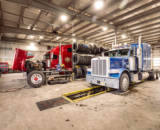/// Guest post by contributor Renewable Energy Group
As I write this in early March, record-low temperatures have hit large portions of the United States, but warmer temps are right around the corner.
And that’s the time of year many travel plazas, truck stops and fleets start thinking about the amount of biodiesel that’s blended into their petroleum diesel.
It’s one of the most common questions biodiesel producers and suppliers are asked: What’s the right blend for me?
It’s an important question, and below I offer three tips to help you answer it.
First, though, a little background for those who are less experienced with biodiesel. The amount of biodiesel mixed into petroleum diesel is the product’s blend level. This is commonly abbreviated to “B” and then the percentage of biodiesel in the blended product. For example, B20 is 20 percent biodiesel and 80 percent petroleum diesel.
Now, on to those three key considerations to keep in mind when evaluating your blend levels.
1. Familiarity with biodiesel
New users often start at lower blends, like B5. But once you become more comfortable, you should be asking yourself if you and your customers could realize even greater benefits by moving to a higher blend. Biodiesel has lower emissions than petroleum diesel and typically costs less — and those advantages grow as the blend level increases.
2. Blending economics
Speaking of financial benefits, a question to ask yourself is if there is money to be made by increasing the blend level. The answer often is yes.
In many cases nationwide, biodiesel costs less than petroleum diesel. That means you’ll have higher margins on B20 than you will on B10, and more on B10 than on B5. In an industry where margins are measured in pennies on the gallon, any advantage adds up fast.
Additionally, many states have incentives tied to certain blends, which can give you extra savings. For example, Iowa retailers that sell B5 to B10 blends can claim a 3.5-cent tax credit on every gallon. That goes up to 8.5 cents per gallon in tax incentives for blends of B11 and higher. In Texas, a retailer can save up to 20 cents per gallon on the state fuel tax for selling B100.
3. Seasonality
Although the myth that biodiesel does not perform well in cold weather has been debunked, there are instances when it makes sense to dial down high blend levels because of bitterly cold weather. When warmer weather arrives, retailers can increase blends and take advantage of positive blending economics.
As long as we’re talking about cold weather use, I’ll add that retailers and fleets nationwide use biodiesel blends year-round. Paying attention to the fuel’s Cloud Point is important, but proper storage and handling together with good winter additives help retailers and fleets use B20 in the cold.
Solutions for You
Keep these three considerations in mind when picking a blend level. Ultimately, finding the right blend depends on your unique circumstances. If you’d like help finding the answer, feel free to reach out to me at troy.shoen@regi.com.
Renewable Energy Group. REG is a leading North American advanced biofuels producer and developer of renewable chemicals. REG utilizes a nationwide production, distribution and logistics system as part of an integrated value chain model to focus on converting natural fats, oils and greases into advanced biofuels and converting diverse feedstocks into renewable chemicals. Learn more about Renewable Energy Group.
Subscribe to Updates
NATSO provides a breadth of information created to strengthen travel plazas’ ability to meet the needs of the travelling public in an age of disruption. This includes knowledge filled blog posts, articles and publications. If you would like to receive a digest of blog post and articles directly in your inbox, please provide your name, email and the frequency of the updates you want to receive the email digest.


